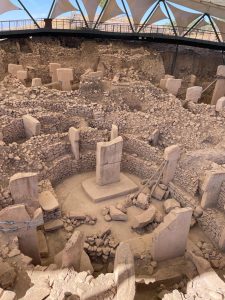Gobekli Tepe means “pot belly” and it was, until recently, the name of a hill located in the South-Eastern Anatolia region of Turkey. It is now the name of an extraordinary discovery buried in the belly of the hill.
About 30 years ago, excavations began at Gobekli Tepe revealing a megalithic settlement dating back 12,000 years. The whole site covers an area of about 12 football pitches and the structures are so old and monumental, they are changing our understanding of civilization.
 Gobekli Tepe is now described as humanity’s first temple. It consists of limestone T shaped pillars arranged in a a number of circular enclosures built over a period of a 1000 years. The pillars have mysterious symbols of wild animals carved on them. At the centre of each enclosure are two large megaliths, about 6 metres in height with human like figures engraved on them.
Gobekli Tepe is now described as humanity’s first temple. It consists of limestone T shaped pillars arranged in a a number of circular enclosures built over a period of a 1000 years. The pillars have mysterious symbols of wild animals carved on them. At the centre of each enclosure are two large megaliths, about 6 metres in height with human like figures engraved on them.
A visitor centre constructed a 2-minute drive from the site, whose modernity juxtaposes the ancient structure showing how far civilization has developed in its art and craft, plays a 2 minute video about the site explaining
“.. A new theory begins to emerge, opening a unique window into our very early spiritual world. The carved human like pillars may represent gods. Animals may be totems or protectors. And a vulture like bird, lifting what could be a disembodied head into the air may hint at ritualised sky burials. The evidence points to Gobekli Tepe as the world’s first known sanctuary. Multiple temples were built over the course of 1000 years, forming an ancient cult centre, bringing people from across the region together for worship”
In 2018 Gobleki was granted UNESCO world heritage status because “The communities that built the monumental megalithic structures of Göbekli Tepe lived during one of the most momentous transitions in human history, one which took us from hunter-gatherer lifeways to the first farming communities. The monumental buildings at Göbekli Tepe demonstrate the creative human genius of these early (Pre-Pottery Neolithic) societies.”
The region around Gobekli Tepe is also seeped with ancient myth and includes the city of Harran, designed in the shape of a crescent moon and regarded as the sacred city of the moon god “Sin”. Other ancient cities including Mardin, Batman, Dyabakir are within 100 km of Gobekli Tepe, all containing memories of ancient pagan belief systems.
The nearest city to Gobekli is Urfa aka Sanlurfia and fabled as the city of prophets. It is reputed to be the birthplace of Abraham, father of the Jewish, Christian and Islamic religions. You can visit the cave where Abraham was born and listen to the gentle and mesmerising dhikr recited daily at the site.
Similar sites to Gobleki have also been found within 100km of Gobleki and include Hamzen Tepe, Sefer Tepe, Tasli Tepe, Sefere Tepe, Tasli Tepe, Kurt Tepe. They are collectively known as Turkey’s pyramids but built 7000 years before the Egyptian pyramids and 6000 years before Stonehenge. The Turkey pyramids are opening a window into an era and belief systems where even the memory of civilization had been lost.
Gobekli Tepe was discovered because of a mulberry tree that stands silently on top of “the pot belly” hill. It was known as the wish tree and people have been going there to make wishes since, it is claimed, ancient times. Locals would travel to the top of Gobekli Tepe and tie a ribbon around branches of this tree or make sacrifices under the tree. The locals believed this tree granted wishes, especially to those who could not have children. It was a tree of fertility. It was on one of these visits that a worshipper uncovered some sculptures in the buried site.
Nature’s ability to hold memory is astounding. This tree held the remnants of a memory many, many, many, thousands of years old of a magnificent place of worship, buried by time.
Locals would go to pay respect to this wish tree, not knowing that this tree stood on an ancient place of worship. They did not know why this tree, and no doubt trees that stood in the same place before this tree, were regarded as fertility/wish tree.
I travelled to Gobekli Tepe recently with Divya to fulfil a long-held wish to visit the oldest temple in the world, which I first read about in an article in National Geographic titled The Birth of Religion in 2011. I also wished to visit the surrounding heritage and to pay respect to this remarkable tree, which kept, in its own way, the memory of Gobekli alive.
Whilst sitting under this tree I was struck by the capacity of nature to hold information in its very fabric. Under this tree, whilst looking out across the plain, my eyes ran along to the horizon. They were met by the sky and experiencing the silence filling the space between the sky and plains, I was reminded of a peace mantra that pays homage to peace in the very fabric of the elements of nature.
The peace mantra is to be found in the Yajur Veda, one of the four books of the Vedas written many thousands of years ago.
The peace mantra is an ode acknowledging peace in the elements of nature. These elements hold humanity. The voices of conflict have the capacity to drown out peace, rather like Gobleki being covered for many thousands of years. This mantra is a reminder, rather like the mulberry wish tree, that peace is omnipresent. Nature is pervaded by it. It’s in the vastness of the sky, in the stillness and flow of water, in the capacity of space to be everywhere and be filled, in the earth’s ability to digest and give life to plants and in turn, their ability to nourish.
The mantra is a reminder of peace, and if you do not see it, where to find it.
shanti, shanti, shantih
If you would like to know how to recite this mantra in sanskrit, follow this link (The Peace Mantra at Gobekli Teppe wish fulfilling tree)
English translation of Universal Peace Mantra
May there be peace in the Space
May there be peace in the Sky
May there be peace in the Earth
May there be peace in the waters
May there be peace in plants
May there be peace in the herbs
May there be peace in the forces
May there be peace in Brahman
May there be peace everywhere
May peace itself be peaceful
Peace Peace Peace
In Sanskrit
Om Dyauh Shaantir
Antariksham Shaantih
Prithivi Shaantir
Aapah Shaantir
Oshadayah Shaantih
Vanaspatayah Shaantir
Vishve Devaah Shaantir
Brahma Shaantih
Sarvam Shaantih
Shantireva shaantih
Saa Maa Shanti Edhi
Om Shanti Shanti Shanti
Rajesh Rai
11 October 23
